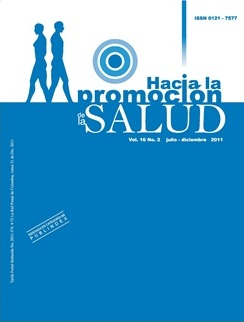Authors
Abstract
Objective: To describe the degree of disability in adult population with spinal cord injury and correlate it with social-demographic, clinical and access features as well as sufficiency and satisfaction with rehabilitation services in the city of Manizales (Colombia). Materials and methods: a descriptive correlational study with forty-five 18 year old people with varied etiology, neurological level and completeness with more than six months evolution was carried out in health and rehabilitation Institutions in Manizales (Colombia) between the second semester 2009 and the first semester 2010. The WHO DAS II and the ASIA Impairment Scale were used. Results: all participants reported some degree of disability. Significant associations were found between the type of general disability and the type of affiliation to the public health system, professional situation, neurological level, zone of partial preservation, sensory and motor ASIA rates, the lesion evolution time, and number of complications. The complications significantly associated with disability were: urinary tract infections, joint pain, autonomic dysreflexia and intestinal problems. As far as the use of rehabilitation services no meaningful relationship was found with any of the variables but meaningful differences were found between the groups that received accessories and vocational, labour, and educational guidance and those that did not receive such guidance. Conclusions: the correlations found between social-demographic, clinical and contextual variables concerning the situation of disabled people with spinal cord injury indicated the need to implement public health interventions aimed at reducing its incidence, prevent associated complications and promote integrated rehabilitation processes that foster social inclusion.
References
República de Colombia - Presidencia de la República. Política pública en discapacidad: fortalecimiento y movilización social. Comité Regional de Rehabilitación de Antioquia, 1ª ed. Medellín: 2005.
Vásquez-Barquero JL, Herrera S, Vásquez E, Gaite I. Cuestionario para la evaluación de discapacidad de la Organización Mundial de la Salud – WHO-DAS II (Versión española del World Health Organization Disability Assessment Schedule II). Ministerio de Trabajo y Asuntos Sociales. Madrid: 2006.
Kirchberger I, Cieza A, Biering-Sorensen F, Baumberger M, Charlifue S, Post M, et al. ICF core sets for individuals with spinal cord injury in the early post-acute context. Spinal Cord advance online publication, 29 September 2009.
Cieza A, Kirchberger I, Biering-Sorensen F, Baumberger M, Charlifue S, Post M, et al. ICF core sets for individuals with spinal cord injury in the long-term context. Spinal Cord advance online publication, 12 January 2010.
Kirchberger I, Biering S, Rensen F, Charlifue S, Baumberger M, Campbell R, Kovindha A, et al. Identification of the most common problems in functioning of individuals with spinal cord injury using the International Classification of Functioning, Disability and Health. Spinal Cord 2010;48:221-9.
Baron M, et al. The clinimetric properties of the World Health Organization Disability Assessment Schedule II in early inflammatory arthritis. Arthritis Rheum. 2008 Mar; 59(3):382-90.
Hudson M. Clinical correlates of quality of life in systemic sclerosis measured with the World Health Organization Disability Assessment Schedule II. Arthritis Rheum 2008 Feb;59(2):279-84.
Soberg HL, Bautz-Holter E, Roise O, Finset A. Long-term multidimensional functional consequences of severe multiple injuries two years after trauma: a prospective longitudinal cohort study. J Trauma 2007;62:461-70.
Wyndaele M, Wyndaele JJ. Incidence, prevalence and epidemiology of spinal cord injury: what learns a worldwide literature survey? Spinal Cord 2006;44:523-9.
Fiore R, Mendoza D. Evaluación del nivel de deficiencias y discapacidades en pacientes de 15 a 55 años con traumatismo raquimedular, aplicando la clasificación internacional (CIDDM) de la Organización Mundial de la Salud. Boletín Médico de Postgrado 2003;19(4):209-15.
Bhargava A, Gorma PH, Kelly D. Exploración física en traumatismos de la columna: exploración según la American Spinal Injury Association y síndromes de lesión medular espinal. En: Kim DH, Ludwig SC, Vaccaro AR, Chang JC. Atlas de lesiones vertebrales en adultos y niños. 1ª ed. Barcelona: Elsevier España; 2010. pp. 28-36.
Chang KC, Zelaya IG. Caracterización de pacientes con lesión medular atendidos en un Centro de Rehabilitación (Teletón) en Honduras. Rev Med Hondur 2007;75:174-80.
New PW. Functional outcomes and disability after non traumatic spinal cord injury rehabilitation: results from a retrospective study. Arch Phys Med Rehabil 2005;86:250-61.
Hall KM, Cohen ME, Wright J, Call M, Werner P. Characteristics of the Functional Independence Measure in traumatic spinal cord injury. Arch Phys Med Rehabil 1999;80:1471-6.
Young AE. Murphy GC. Employment status after spinal cord injury (1992-2005): a review with implications for interpretation, evaluation, further research, and clinical practice. Int J Rehabil Res 2009;32:1-11.
Rowell D, Connelly LB. Personal assistance, income and employment: the spinal injuries survey instrument (SISI) and its application in a sample of people with quadriplegia. Spinal Cord 2008;46:417-24.
Franceschini M, Di Clemente B, Rampello A, Nora M, Spizzichino L. Longitudinal outcome 6 years after spinal cord injury. Spinal Cord 2003;41:280-5.
Amsters D, Pershouse K, Price G, Kendall MB. Long duration spinal cord injury: Perceptions of functional change over time. Disability and Rehabilitation 2005;27(9): 489-97.
Krause JM, Coker JL. Aging After Spinal Cord Injury: A 30-Year longitudinal study. The Journal of Spinal Cord Medicine 2006;29(4):371-6.
Charlifue S, Gerhart K. Community integration in spinal cord injury of long duration. NeuroRehabilitation 2004;19:91-101.
Sipski ML, Jackson AB, Gómez-Marín O, Estores I, Stein A. Effects of gender on neurologic and functional recovery after spinal cord injury. Arch Phys Med Rehabil 2004;85:1826-36.
Krause JS, Broderick L. Outcomes after spinal cord injury: comparisons as a function of gender and race and ethnicity. Arch Phys Med Rehabil 2004;85:355-62.
McColl MA, Arnold R, Charlifue S, Glass C, Savic G, Frankel H. Aging, spinal cord injury, and quality of life: structural relationships. Arch Phys Med Rehabil 2003;84: 1137-44.
Hitzig SL, Tonack M, Campbell KA et al. Secondary Health Complications in an Aging Canadian Spinal Cord Injury Sample. Am J Phys Med Rehabil 2008;87:545-55.
Charlifue S, Lammertse DP, Adkins RH. Aging With Spinal Cord Injury: Changes in selected health indices and life satisfaction. Arch Phys Med Rehabil 2004;85:1848-53.


 PDF (Español)
PDF (Español)
 FLIP
FLIP






















